A new Army-led alliance launched this week to better understand how Soldiers can use all kinds of networks to prevent or dominate conflict.
Major General Nick Justice, Commander of the U.S. Army Research, Development and Engineering Command, delivered the keynote at the formal launch of the Network Science Collaborative Technology Alliance June 23 in Cambridge, Mass. The launch came about thanks to a September 2009contract award to a consortium of four institutions chosen from a field of 18. The contract could be worth more than $166 million over 10 years.
The NSCTA program brings together government, academic institutions and industry to do research that cuts across academic and industrial boundaries so the Army can gain a fundamental understanding of common underlying science among social-cognitive, information and communications networks. The goal is to develop a scientific foundation for modeling, designing and predicting the behavior of very large networks of humans interacting with each other, said Army research officials.
The RDECOM Cooperative Agreement Manager is Dr. Alexander Kott, the Network Science Division chief at the Army Research Laboratory. He will form and lead the government Research Management Board with representatives from RDECOM's centers and laboratories, the other military services and other government agencies.
"The Army is moving rapidly and ever deeper into a network-centric world. So much now depends on how Warfighters and sensors and weapons communicate information through mobile, self-forming, rapidly-changing networks," Kott said. "Here, we see the same three intertwined types of networks: social-cognitive (Warfighters), battlefield information, and communication nets."
The Alliance is made up of centers for those three areas and an interdisciplinary center, all designed to work closely together. The Information Networks Academic Research Center is led by the University of Illinois-Urbana Champaign, the Communications Networks Academic Research Center is led by Penn State University, the Social-Cognitive Networks Research Center is led by Rensselaer Polytechnic Institute, and the Interdisciplinary Research Center is led by Raytheon BBN Technologies.
Unlike some research efforts, the need for this research became apparent after success rather than failure, Justice said.
"When we went into Iraq in 2003 none of our military communications systems worked. Why' Because they were rigid. They did not move. They were not designed to move as fast as we needed them to. The only thing we had was a computer on all our combat platforms networked together sharing a tiny satellite connection, 1,100 computers sharing five kilobits of bandwidth per second. That is not a lot of bandwidth - you weren't going to do streaming video on that network. But what it did was revolutionize the way we fight. Believe it or not, 1,100 combat platforms sharing 5 kilobits per second completely turned us upside down," Justice said.
That network connection allowed the Army to overcome restraints in place for thousands of years, he added.
"The march to Baghdad goes down in history as an unprecedented military maneuver because the Army became self-correcting," Justice explained.
"We did not have to play football. What I mean by that is the Army fights and then stops. This goes all the way back to the Roman legions. You stop at night, get everybody all huddled together to figure things out: where are you, let me find you on a map, resynchronize your orders, adjust what you need to do, and get ready to get up in the morning and start all over again. We didn't play football for 22 days. We did not stop and huddle. We played soccer. It was run and gun. It revolutionized what we do."
More to the point, it started a revolution, he said.
"We've been struggling now for most of a decade to figure out how to better understand what we're doing. We've got megabits of bandwidth now, but it's only (a little bit) better. Why' Information overload."
The NSCTA hopes to help the Army overcome that problem and many others, but it is a new field, Kott said.
"It was only a few years ago that scientists realized that networks of all kinds--biological, social, computer--are in a unique class of creatures, which live their own mysterious lives," said Kott. "They evolve, change, behave in little-known ways and all this is very important to understand and to study."


Social Sharing